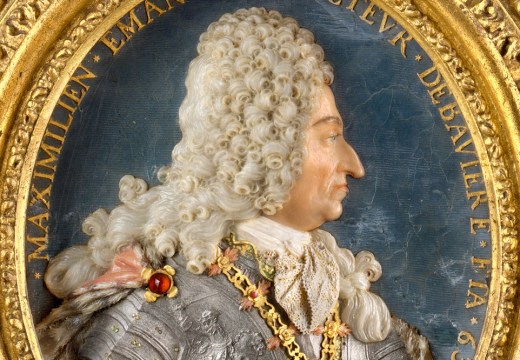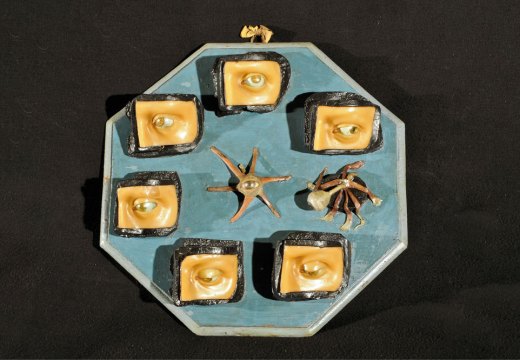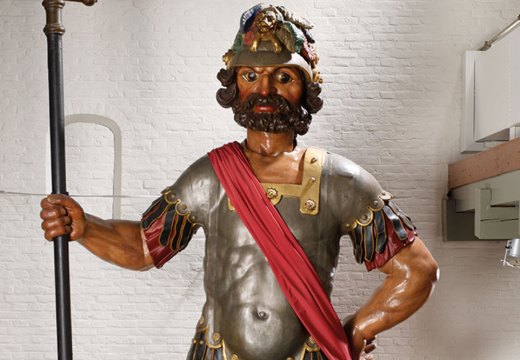From the May 2023 issue of Apollo. Preview and subscribe here.
Every period has its own version of the ‘uncanny valley’ effect, in which an eerie human likeness seems to blur the boundaries between nature and fiction. Today it is images generated by AI – Levi’s, for instance, has hit the headlines for announcing plans to test AI-generated fashion models, while a seemingly candid photo of the current Pope clad in a white puffer jacket went viral before it was revealed to be a deep fake. In earlier centuries, however, it was wax sculpture that transgressed the boundaries between human and artwork. Waxworks, such as those found in Madame Tussauds, may be what first spring to mind when people think of wax portraiture today, but they are the descendants of several quite different kinds of imitation and memorialisation in wax, many of which are now gone, if not entirely forgotten.
Wax has an uncanny ability to replicate human flesh in its translucent appearance and, to a certain extent, touch. Its innate malleability makes it ideal for sculpting the intricate detail required to produce faithful portraits. Giorgio Vasari praised the creations of the Florentine wax-worker Orsino Benintendi (c. 1440–98) as ‘lifelike and so well made that they no longer resembled wax men but living ones’. It’s not surprising that wax became the material par excellence for anatomical sculpture from the 18th century onwards, portrait busts and medallions, and the figures that populated public wax museums.
It is the blurring of lines between living being and sculpture that underpins ‘Cere Anatomiche’ (anatomical waxes), an exhibition currently at the Fondazione Prada in Milan (until 17 July), which includes a short film by the Canadian film director David Cronenberg. Cronenberg has cast four 18th-century female waxworks, often referred to as anatomical Venuses, as protagonists in a short film: Four Unloved Women, Adrift on a Purposeless Sea, Experience the Ecstasy of Dissection (2023). The director views the figures not only as scientific tools, but also as ‘living characters who seemed to be in the throes of ecstasy’. It is the startling visual likeness between the waxes (some of which were created as whole women able to be ‘dissected’, so that layers of anatomy could be peeled away) and ‘real’ people which allows for this identification.
Wax stood in for the human figure even earlier than the 18th century. By the Middle Ages it was an established material for ex-votos. These were sculpted objects left at a shrine to request or give thanks for divine intervention, most commonly in cases of illness or imminent danger. Part of a wider votive tradition, ex-votos could be made in any shape or size, but certain types became established, including small-scale sculptures of body parts, figures, animals or buildings. In 1943, a year after a bomb fell on Exeter Cathedral, examples of this type were discovered hidden above the tomb of Bishop Edmund Lacy. They date to at least before Henry VIII’s break with Rome in 1534. Although for the most part fragmentary, one whole figure of a woman does survive from Exeter, six centuries after it was crafted. Also common were large-scale, sometimes life-size, ex-votos depicting the devotee and often made in wax, although other materials, such as metals or a form of papier-mâché were also in use. One such example, the kneeling figure of Count Leonhard of Görz in wax and wood, dating to 1470, can now be found in the Tiroler Landesmuseum Ferdinandeum in Innsbruck.

Votive statue of Count Leonhard von Görz (c. 1470) Master of the Sonnenberg- Künigl Altar (late 15th century). Tiroler Landesmuseen, Innsbruck. Photo: TLM
Shrines that were known to house miracle-working artefacts (such as relics, tombs, altarpieces or crucifixes) were popular locations for ex-votos. For example, in the 13th century a Florentine woman named Benevenuta had a son who was considered certain to die. She prayed to Umiliana, a recently deceased Florentine Franciscan tertiary, and vowed to place a wax ex-voto on Umiliana’s tomb at the church of Santa Croce should her son be restored to health. The child recovered ‘without any drug’ and Benevenuta fulfilled her vow. Some shrines, such as Santissima Annunziata in Florence, attracted a particularly high proportion of life-size figural wax ex-votos. The church houses an image of the Annunciation, believed to have been painted by divine, rather than human hand, which from around 1340 was considered to be miracle- working. The wax ex-votos of Santissima Annunziata were distinguished both by their sheer number – an estimated 600 life-size figural ex-votos by 1630 – and also by their significance, which was socio-political as well as devotional. Rulers from Europe and beyond flocked to be represented in life-size votive form in the church, including Isabella d’Este (Marchioness of Mantua), the Duke of Lorraine, the King of Dacia and a ‘Turkish pasha’, all of whom could be seen in waxen form at the same time from the 1490s onwards. Over time, therefore, Santissima Annunziata began to function as a secular portrait gallery. Whether an ex-voto physically resembled the person depicted by it is a complex question – and one complicated by the fact that no documented medieval or Renaissance examples from Florence survive today. Accurate likeness may not have been important or necessary to those giving or using these devotional artefacts. Just as with any work of art, some ex-votos may have been a truer likeness than others. In some cases, onlookers would also have relied heavily on clothes, accessories and nameplates to identify individuals.
The use of wax ex-votos was not confined to Italy. In January 1276 at Winchester, King Edward I settled an account which included payment for 300 pounds of wax ‘to make an effigy on our behalf’. It is quite feasible that this ‘effigy’ was a wax ex-voto. It may have depicted Edward himself, pledged in request for a successful reign. Alternatively, the wax may have been fashioned into a likeness of Edward’s predecessor, Henry III – designed to ease his passage into the afterlife. Henry III was particularly devoted to Edward the Confessor, who had been canonised in 1161. Henry had adopted Edward as his patron saint, built the saint’s shrine in Westminster Abbey and was temporarily buried in the tomb in which the saint’s remains had been interred before they were moved to the new shrine.

View of the Queen’s Diamond Jubilee Galleries in the triforium of Westminster Abbey, London. Photo: © Alan Williams; courtesy Westminster Abbey
Others have interpreted Edward’s wax effigy quite differently. W.H. St John Hope argued that the payment was for an effigy of Henry III to be carried in his funeral procession on 20 November 1272, although reports of that occasion do not mention the use of an effigy. At the earliest medieval royal funerals, the monarch’s actual body was displayed to the crowd during the funeral procession, but by the beginning of the 14th century an effigy had taken its place. Usually made from wood, these became a feature of royal funerals for several centuries. Nine such effigies, the so-called ‘ragged regiment’, survive to this day and are now displayed in the Queen’s Diamond Jubilee Galleries in Westminster Abbey. The earliest effigy to survive is that of the Plantagenet king, Edward III, from 1377. Carved from a single piece of walnut, and nearly 5ft 11in tall, the figure was carried on top of Edward’s coffin in his funeral cortège. Now a rather minimalist block, at the time of its use the effigy would have presented a far more striking spectacle. With facial features painted on plaster ground and eyebrows made from dog hair, the figure would have been bewigged, bearded and dressed in the robes Edward had worn at his coronation 50 years earlier. For many royal funerals such as Edward’s, the ceremonial robes of estate were often borrowed from the Great Wardrobe (a department of the royal household which dealt largely with non-perishable items, including clothing and jewellery) for the occasion. However, for others, such as that of James I, replica robes were commissioned. Artisans were also charged with making an orb with cross and a sceptre – symbols of divine and earthly power and replicas of those used at a coronation – to adorn Edward’s effigy on its journey from palace to burial place. As with ex-votos, these garments and accessories were tokens by which the effigy could be recognised as monarch by crowds who had most likely never seen the individual in question.
This format for royal funerals continued with certain variations until the funeral of James I in 1625. Some queens consort also received the same honour. Among those in the collection of Westminster Abbey are the effigies of Catherine of Valois (consort of Henry V) and Anne of Bohemia (Richard II’s queen). Only one child of a reigning monarch, Henry, the son of James I, was commemorated in the same way. Funeral effigies may have been introduced when it was no longer practical to display the monarch’s corpse due to the delay between death and funeral. The viewing of the effigy, and corpse before it, showed that the monarchy continued even after the death of an individual ruler. The pomp could also be a necessary display of power and prestige at times when the succession was contested.
Recent analysis and conservation of the Westminster effigies has indicated that care and attention was taken to produce a suitable, visually pleasing likeness of the individual, often in the short timespan before the funeral at which it was required. The funeral effigy of Henry VII may have been based on a cast of the monarch’s face. Technical analysis undertaken in 1988 indicated that dimensions of the face of the effigy and a terracotta bust of Henry in the Victoria and Albert Museum are practically identical, suggesting a cast of Henry’s actual face as a common antecedent. The terracotta bust is attributed to Pietro Torrigiano, who made Henry’s tomb in Westminster Abbey and, on the basis of the resemblance, the Florentine sculptor may also have made the funeral effigy.
After a monarch’s funeral, their effigy remained in place with the coffin for 30 days, until the funeral rite officially finished with a trental mass. For the medieval effigies, what happened next, beyond their preservation by the Abbey, is unclear. The case of Henry VII’s effigy suggests a possible interim destination. Practically speaking, a tomb was an individual’s final resting place. Devotionally, it provided a physical object to which onlookers could direct prayers believed to be necessary to ensure the deceased’s eternal salvation. However, since it could take quite some time for the tomb to be manufactured, the funeral effigy may have functioned as the focus of prayers and marked the place of burial in the meantime. By 1606, however, and echoing the dual purposes at work at Santissima Annunziata, the royal funeral effigies had taken on an additional function, that of dynastic portrait gallery. It was in this year that the earlier figures were repaired and dressed at King James I’s expense so that they could be displayed to King Christian of Denmark when he visited the Abbey.

View of the life-size wax effigy of Frances Teresa Stuart, Duchess of Richmond (1647– 1702), modelled by Mrs Goldsmith (active 1695–1703), in Westminster Abbey. © 2023 Dean and Chapter of Westminster
Although by the 18th century effigies were no longer used at royal funerals, the practice was perpetuated in some aristocratic circles. Westminster Abbey’s collection contains several examples of this genre, including Frances, Duchess of Richmond, Edmund, Duke of Buckingham and the Duchess of Buckingham. The visible parts of these figures were made in wax rather than wood. Horace Walpole’s near contemporary account highlights that the effigies were valued for their memorialising significance, ‘But though Madame of Buckingham could not effect a coronation to her will, she indulged in pompous mind with such puppet-shows as were appropriate to her rank […] and prepared and decorated waxen dolls of him and of herself to be exhibited in glass cases at Westminster Abbey.’ Not only, therefore, were wax figures a key feature of a grand funeral, but they were also intended to live on at the Abbey, prolonging the memory of the deceased.
As an illegitimate daughter of James II, the Duchess of Buckingham may have wanted to emphasise her royal connection through the use of wax effigies for herself and her son, but a similar practice was employed by Sarah Hare, daughter of a mere baronet in Norfolk. Hare’s will of 1743 outlined her wishes for the creation of a wax mortuary effigy that still watches over her burial place in the church of Holy Trinity in Stow Bardolph, the only surviving example of its kind outside London. The waxen Sarah sits in a mahogany and glass cabinet, visible from the waist up and dressed in crimson satin. It was clearly important to Hare, however, that the effigy be true to life. As stipulated in her will, her face and hands were cast from life (or, perhaps, death). It is, however, difficult to assess whether Sarah Hare’s effigy was an outlier, or, in contrast, is the sole survivor of a wider trend.
Eighteenth-century funeral and mortuary effigies such as these, and wax ex-votos, acted as an important stage in the development of the third type of sculpture in Westminster Abbey: portraits of monarchs and public figures specially commissioned for display. These include effigies of Charles II, William Pitt the Elder and Lord Nel- son. During the 18th and early 19th centuries, Westminster Abbey’s choir charged the public to view the effigies, rid- ing the wave of enthusiasm for waxworks which remains undiminished today. At this time, many of the artists who produced ‘waxworks’, whether for Westminster Abbey, or for display in their own establishments, were women. Precursors of Madame Tussaud included Mrs Goldsmith, Patience Wright and Mrs Salmon. The latter advertised the display of 140 figures in her museum in Fleet Street, with a particular emphasis on royalty. Accuracy (or the claim of accuracy) of both physical appearance and the tableaux in which the figures were arranged was Mrs Salmon’s prime selling-point. A ticket to her establishment describes ‘the effigies of Q[ueen] Catharine, being taken from her own Face, lying on a Bed of State in a Mausoleum, drest in her Royal Robes […] with an attendance suitable to the Solemnity.’ Similar considerations still apply. In March this year, Madame Tussauds in London inaugurated a royal experience which included commissioning a new outfit fit for the recently elevated King Charles III. As for the figures at Westminster Abbey, they remain far less known than their modern counterparts. However, as Charles III inches his way closer to his sovereign destiny during his coronation, these ghosts of monarchs past will be bearing mute witness, nestled around 46 feet above his head.
In today’s multimedia age waxworks may provide little more than an opportunity for tourists to take selfies – or for directors known for their interest in the macabre to cast in films. But there is no doubt that the easy visual equivalence of wax and human flesh sets up a rich contrast between the real and the fictive that is still compelling today.
‘Cere anatomiche: La Specola di Firenze | David Cronenberg’ is at the Fondazione Prada, Milan, until 17 July.
From the May 2023 issue of Apollo. Preview and subscribe here.
Unlimited access from just $16 every 3 months
Subscribe to get unlimited and exclusive access to the top art stories, interviews and exhibition reviews.














![Masterpiece [Re]discovery 2022. Photo: Ben Fisher Photography, courtesy of Masterpiece London](http://www.apollo-magazine.com/wp-content/uploads/2022/07/MPL2022_4263.jpg)
It’s time for the government of London to return to its rightful home